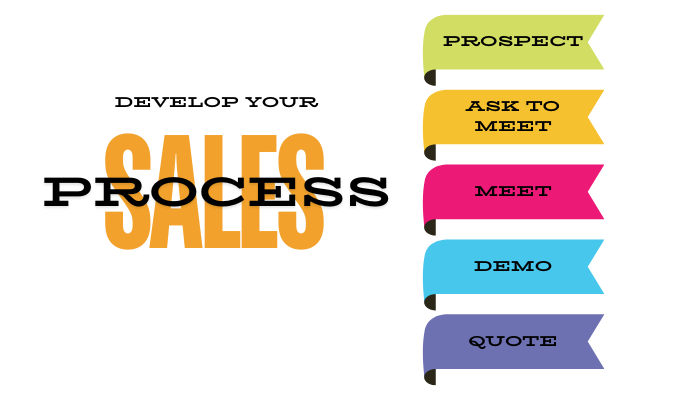Are you trying to reach prospects and finding it difficult to connect with them? Maybe you’re trying to stop by to see them and the doors are locked or individuals you’re trying to reach don’t even work in the office anymore.
Whatever the case is for you, there’s a few sales prospecting techniques you need to consider, and the most important component is to have a process that you use that generates repeated results.
Now, the trick is, what’s that process? I’m sure you’ve tried processes before.
Well, here’s the key:
When it comes to a process and setting up steps, the first goal in prospecting is for you to figure out what is the best channel that my prospect prefers to communicate on? Once you know that, then you’ve got them locked in and you can really kick things off and move the relationship forward.
So that’s what we’re going to talk about today, how to develop your own process and really figure out what is the best way to connect with my prospect.
5 Steps to Developing Your Sales Process
Now, let’s get into it rather than talk about how to connect with prospects first. Here’s the thing. We have to be ready for success. We have to be prepared for success. If you unlock the keys to actually connecting with people, you’re going to be flooded with prospects.

(1:29)
So before you get there, because then we start to drop the ball, we don’t get back to them quickly start to fall through the cracks. We forget about what the next steps are, which is all bad. Okay?
Step 1: Qualify Through Testing Several Channels
So step one, you’ve got to have a quick qualifier. You’ve got to have a way by which you can qualify people very quickly so that are they ideal for me to spend time with or not? You see, time is the limited variable that all of us deal with, and if you’re in sales and you recognize sales as an activity based role, it’s based on numbers.
The more people you connect with, the better off you’re typically going to be. But as we connect with people, we’ve got to know which ones are the best ones to connect with. So we’ve got to manage your time. So what is a quick qualifier for you?
(2:08)
How will you know when you connect with somebody if they’re the best person for you to spend your time with? Here’s how I suggest you do that.
Sales Prospecting Technique 1: Create Your Sales Qualification Framework

- First off, think about the decision maker. What is the title of the individual that you typically would sign off on or assign the budget to whatever it is you sell.
- Next, identify all of the people that typically influence this individual. So they might not have final say, but they might have some say, might be somebody in purchasing or supply chain, might be an engineer, might be a designer, could be a spouse. If you’re selling to family businesses, who are those people?
- Once you’ve identified those, the next step is really identifying what is the best company for me to pursue. Now this could be just looking at the location of the company and saying, well, I want to sell to companies in this area. Or you might say, well, it’s companies of a certain size that really matter. So identify the criteria that best describe the companies you prefer to sell to. If you’re not sure what these are, take a look at your existing customers and say, okay, which have been the best customers for us?
- If you’ve identified the criteria of those companies based on size, based on location, based on maybe what they sell themselves or what they provide into the market, you’ve now got the information you need to really identify the criteria for your ideal prospect.
There is a quick qualifier you can use, and with this information in hand, as you’re wading through these prospects, you’ll know who to spend your time with and who not to. Now, let’s get to the next step.
(3:40)
As I mentioned in the start of this video, the key to your prospecting process, I like to call the Unstoppable Sales Prospecting Process.
Excuse me, that is actually outlined in my book, the Unstoppable Sales Machine. Here’s the key. Here’s something I didn’t talk a lot about in the book:
Sales Prospecting Technique 2: Determine your Prospect’s Preferred Communication Channel
Step one in prospecting is to figure out how do I best communicate with this person? You want to have a process that really is designed to test different communication channels.

Let me give you an example:
You might start with a phone call, okay, now what’s the purpose of the phone call? Well, it’s to try and connect with somebody, but chances are it’s going to go to voicemail. But in the voicemail you mentioned, you’re going to send an email and you leave them your phone number and say, if you’d like to call or text, here’s my number. So now I’ve tried to call them and I’ve offered my phone number to call me back and text.
Then I send an email later on that day, no later than the next morning, but preferably that day with something similar. And again, I’m not going to talk about the structure of the email at this point, but you send an email now, you’ve now given them three different channels, three different channels to communicate with you on email, telephone, texting.
If you get nothing from that email within a couple of days, I would reply all, send it again, and test that channel again, because it’s a very common channel that people will use when they’re first connecting with salespeople. But if you get nothing after another several days, go to LinkedIn, send a personalized note and a connection request.
Notice what we’re doing here. We’re testing different channels.
(5:01)
- If they reply on LinkedIn, don’t go back to email. Use LinkedIn messaging.
- If they reply on email, don’t go text them, use email.
- If they text you back, use that channel.
So step one of your process really has to be figuring out the best channel to communicate with them on. okay, now your process then changes because it’s not about saying, I do this, then this and this.

It’s about saying, I test each of these channels in my first several steps to figure out the best channel to communicate with, and then I pursue them on that channel.
So there’s the introduction, if you will, the beginning stages of a prospecting process you can use. You’ve got to be adept at communicating on multiple different channels. Don’t force them back to one. Don’t force ’em back to email. If they want to talk on the phone, don’t force ’em back to LinkedIn messaging if they want to have a zoom call!
(5:46)
You’ve got to be good on all these channels. Think about it like a tool belt with different tools. You’re pulling out the appropriate tool depending on what the other person’s signals to you is important to them. Moving forward, then let me give you five steps you should have in your prospecting process to ensure you’re effective. Step one is your channel testing, and I just went through that in the last step.
Step 2: Request an Initial Conversation
The next step is your initial request, and that request is typically to have a conversation, a meeting to stop by, whatever it is.
Part of that request should be your reason for the request. So maybe you got referred into them, maybe you drove by and saw them and think they’d really be an ideal customer or they’d appreciate whatever it is you’re selling. So that’s step two.
Step 3: Meet (Virtually or In Person)

Step three is your meeting. That could be virtual, that could be in person, that could be just over the telephone.
Step 4: Demonstrate Credibility
(6:33)
Step four in your prospecting process is to share value, share credibility. So that could be a leave behind as far as just lists of testimonials, that might be a referral that you bring into the conversation. That could be just information on your website that shows video testimonials of past clients that you share with them, but it’s got to be that credibility step.
Step 5: Move Toward a Quote
And then step five is moving towards a quote. Now, depending on what you sell, that’s going to differ. You may have two or three meetings. This could span over a year. But what I want you to notice is some of those unique steps in there that we often don’t think about, right, as far as a prospecting process. So use those five steps repeatedly and formulate your process, test some different things, whatever works, make it something you use repeatedly. For those that you invest time in prospecting, the next challenge becomes how do I stay in touch with them?
Sales Prospecting Technique 3: Nurture Prospects Not Yet Converted
(7:19)
So you have to have what I refer to as a nurture process. Now, that nurture process is really information and value you share with prospects that you’ve not yet converted.

So consolidate those people that you’re working with, you’re talking to, but they’re not closed yet, and about every quarter just sent them something of interest, not something to sell them. It could be new information on a product that your company has introduced. It could be insights around the market that affects them and how it might affect them. Or, it could be anything at all that they might find interesting, but share that with this group of people that’s not yet converted every quarter.
That allows you to stay top of mind and ensures you continue adding value to build trust through the relationship.
Convert Faster: Familiarize Your Prospects with Your Sales Process
Then there’s just one last thing you need to do if you want to convert prospects faster, and here’s what it is early in the conversation, once they’ve suggested they’re interested.
 (8:08)
(8:08)
So this could be during your first call, this could be during your first meeting, but where you get the sense that, yeah, they’re interested moving forward, you want to make sure you tell them what the next steps are to moving towards being a customer.
So for example, if we’re having a meeting and the meeting’s gone well, I say, well, look, I just want to walk through what the typical next steps are that we would take from here. Is that okay with you? (I ask permission, they say “Yes, sounds good”.)
- So from here, typically we’ll do a demonstration. Following the demonstration, we’ll answer any questions you have.
- If that’s good, we’ll have another meeting.
- And in that meeting we will discuss with you a potential proposal or a quote, make sure it’s going to be good for you.
- We’ll issue that quote, we’ll follow up on that quote, and if everything looks good at that point, we would move forward.
- Does that sound good to you?
You see, I want to paint the picture of the steps that are going to happen. I don’t want people to be confused as to where we’re going.
This is also a chance for them to say, Hey, hold on a second. This is something that is not what I expected, so let me ask some questions.
So make sure you lay out the next steps so that they can actually see what’s going to happen. This will insure that they’re more interested in the process and they raise any objections early, allowing you to deal with it.
So there you have it steps to create your own best practice prospecting process for yourself. That’s a big month full obviously, and I hope you’ve found value in those steps.
Make sure you can just go back and watch this again if you missed anything, and comment below if you’ve got steps that work really well for you in prospecting.
If you’d like to check out some of the other videos and sales training I have, you’ll find them on YouTube here. And until next time, let’s get out there and go sell something. We’ll talk to you soon.
© Shawn Casemore 2025. All Rights Reserved.



Share This Article
Choose Your Platform: Facebook Twitter Google Plus Linkedin